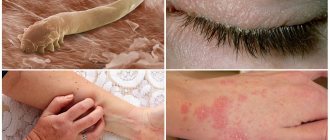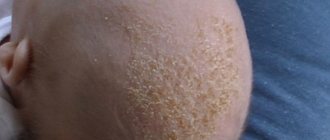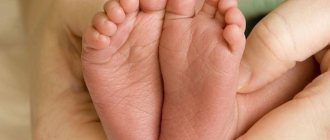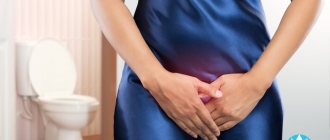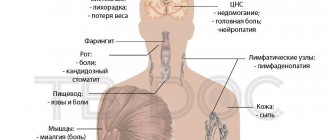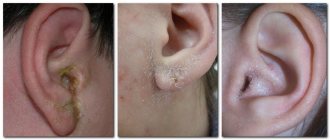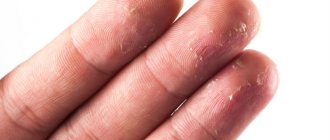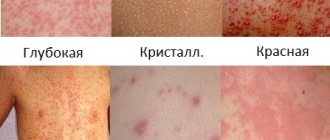Why does a newborn's skin peel off - physiological reasons
During pregnancy, the baby is in an optimal environment, all the skin is covered with vernix. But after birth, the child has to face harsh and unusual conditions - the air is colder and drier, the skin is constantly in contact with clothing.
All this often leads to the newborn’s skin flaking.
There are other reasons:
- improper nutrition of the mother, or inappropriate formula;
- too dry and hot air in the room;
- improper skin care for your baby;
- walking in the wind, low or high air temperature - in this case, the skin on the forehead, cheeks, and chin peels off.
When treating severe jaundice in newborns, phototherapy is often used - the lamps cause the skin to peel off greatly.
These reasons do not indicate health problems; identifying and eliminating them is not at all difficult.
Causes
Seborrheic dermatitis is not contagious and does not mean that your child needs frequent bathing. Doctors still haven't identified the cause, but since the problem typically occurs several months after birth, it may be related to the mother's hormonal state, namely the hormones that continue to circulate in the baby's body. Symptoms of seborrheic dermatitis occur due to overactive sebaceous glands
- located around the hair follicles, which supply the skin and hair with oil to maintain moisture.
Malassezia yeast also plays a role in causing flakes to accumulate on the skin. Hormones, extreme weather conditions and other skin problems can worsen the condition.
Other diseases
While seborrheic dermatitis most often causes dry skin on a child's scalp, the following problems can also lead to dry skin:
- scalp psoriasis
- scalp eczema
- allergic manifestations
The conditions listed above are likely to cause discomfort and your child may have itchy skin. If your symptoms do not resemble those of seborrheic dermatitis, you should consult your doctor.
Peeling as a sign of various pathological conditions
Dry skin in infants is a common consequence of allergic reactions. Peeling can be caused by washing powder, hygiene products, intolerance to cow's milk, fruit and vegetable purees that are used for complementary feeding.
Doctors have found that increased dry skin often occurs in post-term babies and in babies with congenital endocrine diseases.
What diseases cause skin peeling:
- Gneiss or seborrheic dermatitis , etc. In infants, the skin on the scalp peels due to excessive activity of the sebaceous glands, accumulation of sebum. The problem is accompanied by the appearance of crusts on the crown of the head, behind the ears, and in the eyebrow growth area. The disease disappears on its own as the baby grows older, usually by 6-12 months.
- Diaper dermatitis . The disease develops with prolonged contact of the baby's skin with clothes made of synthetic materials if particles of detergents remain in the folds.
- Diathesis. This is not even a disease, but the body’s predisposition to allergic reactions, which is inherited. Symptoms: the skin on the forehead and cheeks is dry, redness, diaper rash, cracks and blisters are observed. At the same time, the child is capricious, sleeps poorly and gains weight, and sometimes the temperature rises.
- Diseases of the digestive system . With such pathologies, the process of the body’s absorption of nutrients from milk or formula is disrupted, vitamin deficiency develops, which negatively affects the condition of the epidermis, the newborn’s skin peels, and other dermatological pathologies are observed.
- Dehydration . Develops with vomiting, diarrhea, at elevated temperatures, in the hot season. The child's skin becomes thin and dry, the number of urination decreases, and sometimes the fontanel becomes sunken.
- Fungal diseases . Mycoses are transmitted to children from parents. The disease affects the scalp, legs and arms, accompanied by peeling and severe itching.
- Bacterial infections.
If you are very concerned about peeling skin in a newborn, the problem is accompanied by other unpleasant symptoms, contact a pediatric dermatologist.
Dandruff in a child: treatment for children 7,9,10 years old, adolescents and newborns
Dandruff is a rather unpleasant phenomenon on the head, which can be observed not only in adult patients, but also in children.
The pathological condition brings not only physiological, but also psychological discomfort. That is why it is recommended to carry out its timely treatment.
Photo
Photographs of dandruff show that this disease is pronounced. This allows you to notice it with the naked eye . Dandruff appears in the form of small scales that are noticeable on the scalp and hair.
What to do?
treated immediately . It can be general and local .
General therapy consists of providing a balanced diet to the child. It is also necessary to normalize the performance of all systems and organs.
This requires timely treatment of various pathological processes in the baby’s body. The child must follow a daily routine.
Local treatment consists of the use of appropriate medications, the action of which is aimed at eliminating white scales:
- vegetable oils;
- medicated shampoos;
- folk remedies;
- hydrolate;
- head massage;
- sulsen soap;
- masks.
The choice of a specific medication should be made by a doctor in accordance with the individual and age characteristics of the child.
In newborns
Dandruff in a newborn baby appears in the form of crusts that have a yellow tint . They appear most often against the background of insufficiently developed delicate skin. The cause of the pathology may be an allergic reaction or metabolic disorders. Pathology can occur if the child is not cared for properly.
Removing crusts on the head of a newborn baby is quite simple. To do this, you need to thoroughly wash the child's hair. After this, almond, coconut or vegetable oil is applied to the skin. After the crusts have softened, they are removed using a brush that has soft bristles. At the final stage, the hair is washed again.
To avoid pathology in infants, it is recommended to regularly wash the hair using decoctions of medicinal herbs.
In children
Dandruff in children can develop at different ages. Quite often, the pathology appears at the age of 7 years. It develops against a background of stress that is caused by the child going to school.
Also, the pathology can be diagnosed at the age of 9 or 10 years.
To ensure effective and rapid treatment of young patients, the most common use of hydrosols is herbal or floral aromatic water:
- Jasmine.
- Daisies.
- Lavender.
After washing your hair, apply a few drops of medicine to a cotton swab and wipe the skin with it.
Traditional medicine is quite effective and safe in the treatment of pathological conditions . Experts recommend using tea tree oil for this purpose.
A few drops of this extract should be added to regular shampoo and used to wash your hair.
It is also recommended to rinse your hair with infusions of plants such as chamomile and nettle.
The skin of a 7-10 year old child is very delicate. That is why it is necessary to carefully select the means for treatment, which will eliminate the possibility of unwanted effects.
In teenagers
In adolescence, the appearance of dandruff is most often diagnosed due to hormonal imbalances . If a teenager has serious endocrine disorders, he is prescribed hormonal drugs.
In their absence, dandruff treatment is carried out using local medications - Dermazol, Nizoral, Tar Shampoo, products whose main component is salicylic acid.
My head itches
Dandruff is often accompanied by unpleasant symptoms, one of which is itching. To eliminate it, it is recommended to use products that have an antiseptic effect. Traditional medicine suggests using chamomile decoction to combat itching. You can also use medicines based on plants such as rosemary, sage, parsley, etc.
To combat the symptoms and the disease itself, it is recommended to use Nizoral or Tar shampoo. These drugs are developed on the basis of tar, the action of which is aimed at combating the inflammatory process. Also, thanks to this component, the activity of the fungus is inhibited.
Elimination of itching is often carried out using drugs based on salicylic acid, which effectively fights inflammation. Some patients are recommended to use Octopirox, which is characterized by the presence of antifungal and antibacterial effects.
Strongest form
If a child has a severe form of the pathological process, then complex treatment is indicated. The baby must adhere to a diet.
It is recommended to use vitamin complexes internally, which will help restore normal functioning of the body.
During treatment of pathology, young patients are advised to adhere to a diet, as well as regularly walk in the fresh air.
In this case,
a competent selection of drugs for local treatment is required.
For this purpose, it is recommended to seek help from a doctor who will prescribe the drug in accordance with the type of seborrhea. Most often, the use of Sulsen detergents is recommended to eliminate pathology. Application of the products is recommended once a week. If a child is diagnosed with oily seborrhea, treatment should be carried out twice a week.
If a child is diagnosed with excessive sebum production, the use of special masks is recommended.
A product based on aloe juice, which must first be diluted with alcohol, is quite effective You can also use myrtle leaves for this purpose.
The products must be used with the utmost caution, as long-term exposure to the skin may cause burns.
Dandruff in children is an unaesthetic and unpleasant disease that must be treated promptly.
For this purpose, it is recommended to reconsider the baby’s lifestyle, as well as use drugs that have a local effect.
If dandruff does not go away within several weeks of treatment, then it is necessary to conduct an examination of the child’s body to determine the cause of the disease and eliminate it.
Source: https://tricholog.org/zabolevanija/seboreja/vidy/perkhot/u-rebenka-2.html
Dry skin in a newborn - what to do
If peeling appears on the baby's head, do not try to remove the crusts - this way you will injure the baby's delicate skin; dangerous microorganisms can penetrate through microcracks, which will cause the appearance of pustules.
To soften the crusts after bathing, you can treat them with Vaseline, baby oil, or boiled vegetable oil.
If increased skin dryness is not associated with health problems, use high-quality moisturizers to combat flaking.
The best moisturizers for babies:
- Weleda cream with marshmallow . It has a natural, hypoallergenic composition, ideal for children's sensitive skin. Retains moisture in the tissues of the epidermis, protects the skin from the negative influence of external factors.
- Children's series Siberica . All products contain natural oils and herbal ingredients, do not cause irritation, and are low in cost.
- Children's cosmetics from the company Bubchen . The line includes all the products needed to care for your baby. Good quality products from German manufacturers, but the price is quite high.
- Sanosan . Cosmetics do an excellent job with eczema, dryness, peeling, diaper rash and dermatitis. The composition is completely natural, but contains parabens. The cost is high.
- Blizzard . An effective and inexpensive product to protect your baby's skin from frost and wind. But the composition contains preservatives, the cream takes a long time to be absorbed.
Many of these brands also produce sunscreens for children. But any of them can only be used from 6 months, even if 0+ is indicated on the package.
When treating atopic dermatitis, ointments with hormonal components are prescribed. Use them only as prescribed by your doctor and follow the instructions carefully.
Before you start using any product, remember that what is ideal for one baby may not be suitable for your child at all. Therefore, after applying a protective or moisturizing agent, carefully monitor the condition of the baby’s skin and general well-being.
A child has very dry scalp: what to do in this case and how to help the baby?
Skin is considered an indicator of the health of the entire body.
Dryness, peeling, itching may indicate many pathologies provoked by external or internal factors. Dry scalp is not uncommon among children. A very dry surface of the epidermis leads to the appearance of dandruff, even at an early age. Why does this condition occur in infants and older children? What to do and how to treat so as not to harm the baby’s health?
Main causes of dry scalp in children
The main causes of dry skin in infants (children under 1 year):
- very delicate and soft skin, susceptible to mechanical stress and infections;
- unsuitable cosmetics (shampoo, gel, powder);
- unfavorable microclimate in the living space (dry or too humid air, heat);
- constantly wearing a hat - this leads to diaper rash;
- unformed sebaceous glands (the problem goes away as you get older);
- reaction to new foods (complementary foods or diet of a nursing mother);
- deficiency of vitamins and microelements;
- metabolic disorders in the mother during pregnancy, etc.
Causes of dandruff in children after 1 year:
- incorrect approach to personal hygiene or unsuitable care products;
- poor nutrition, which causes vitamin deficiency;
- passion for unhealthy foods;
- food allergies;
- psoriasis, dermatitis and other skin diseases;
- fungal infection;
- disturbances in the gastrointestinal tract;
- the presence of parasites in the body;
- stress and nervous disorders caused by entering kindergarten, school and other important events;
- disturbances in the functioning of the sebaceous glands (appear in diseases of the endocrine, nervous or digestive system).
Symptoms of dry skin
This condition is characterized by pale scalp with visible microcracks. With excessive dryness, small light-colored scales appear, which are dead epidermal cells. The child experiences itching and discomfort.
Cracks or abrasions appear on the child's head due to inaccurate combing. An infection (bacteria or fungus) gets into the wounds, which can result in suppuration. As the pustules heal, they become covered with a dense yellow crust.
The painful state of the epidermis certainly affects the health of the hair. They become brittle, grow slowly, and fall out. Such children are more likely to suffer from baldness. Hair follicles need water, collagen and other components for full growth, and very dry skin lacks these components.
How to treat?
Treatment must be correct and reasonable. Help directly depends on the causes of the problem and accompanying symptoms. Treatment includes general recommendations for children and parents, as well as the use of special remedies or folk recipes.
General recommendations:
- Apply baby oil generously to infant crusts 20 minutes before bathing. Afterwards, gently comb your head with a soft comb or baby brush.
- It is better not to use shampoos until the child is one year old. Once a week you can wash your hair with soapy water.
- Children's cosmetics should be age-appropriate and hypoallergenic. The choice should be made in favor of proven brands.
- Skin prone to dryness needs to be moisturized. After bathing, she should be treated with age-appropriate oils or baby cream (only on undamaged areas).
- Avoid diaper rash. Do not wear hats indoors. Avoiding a bath or sauna will only make the problem worse.
- Take care of air humidity and optimal room temperature (20-22 degrees). An air humidifier will be a useful purchase.
- Avoid dehydration, as this also affects the skin. The baby should drink enough clean water.
- Buy bed linen only from natural materials, avoid aggressive dyes. A children's hypoallergenic detergent is suitable for washing.
Treatment with special drugs
A preliminary examination by a specialist (dermatologist, trichologist) is required. The doctor will examine the child, take the necessary samples and tests to make an accurate diagnosis and determine the causes of the disease. Then he will prescribe a course of treatment and give recommendations regarding lifestyle and nutrition.
Pharmaceutical drugs:
- Nizoral (shampoo, cream). The active substance ketoconazole effectively combats the problem of dandruff in infants, older children and adults. Apply 1-2 times a week. The course of use is individual, approximately 1 month. Avoid contact with eyes, mouth and nose. Nizoral has many analogues with an identical active ingredient, which are much cheaper - Dermazol, Perhotal, Kenazol, etc.
- Sulsena (shampoo, mask, soap, paste). Suitable for children. Contains selenium disulfide (2.5%). Relieves itching, strengthens hair roots, protects skin from negative effects. Apply once a week. The product is applied for 15 minutes and then washed off. Sulsena is quite affordable in terms of pricing, costs about 100 rubles.
- Shampoo Friederm zinc (FreeDerm). Contains 2% zinc pyrithione, which has antimicrobial and antifungal effects. Suitable for children, adults and pregnant women. The first 14 days are used 2 times a week, then 1 time. The course of treatment is approximately 1.5 months.
Traditional medicine
In folk medicine, burdock oil is considered the first assistant to solve this problem. Apply to dry hair for 1 hour, keep your head warm. Then wash off the oil with warm water and shampoo.
Onions can also help. Finely chop the onion, wrap the resulting mass together with the juice in gauze, folded in several layers. Rub the onion mixture generously onto your head, leave for an hour, then rinse. Repeat twice a week.
Egg yolk effectively nourishes dry skin. It needs to be mixed with a small amount of water, applied to the head, wrapped with film and a towel, and left for 30 minutes.
A mask with honey and olive oil is used not only for the face, but also for the scalp. Mix heated honey and oil in a 1:2 ratio and apply to the head. Leave on hair for 20 minutes, rinse with shampoo and herbal decoction.
Diet food
The diet concerns both the children themselves and nursing mothers whose babies are faced with a problem. It consists of proper and balanced nutrition, rich in vitamins. Allergenic foods, harmful semi-finished products, and sweets are completely excluded from the diet. If the child is bottle-fed, it is worth temporarily switching to a special hypoallergenic formula.
Prohibited products:
- whole cow's milk;
- seafood;
- nuts;
- chocolate and coffee;
- red berries, citrus fruits;
- honey;
- any semi-finished products;
- candies and sweets;
- soda, etc.
What complications can a child have from dandruff?
Dandruff and dry skin are fraught with excessive hair loss and baldness. This complication is difficult to treat and requires a lot of time and effort. A complication of infantile crusts is chronic seborrheic eczema.
INTERESTING: reasons why a child’s skin may become dry
Preventive measures
For the purpose of prevention, it is recommended to follow the following rules:
- proper balanced nutrition;
- avoiding excessive sweating of the head (warm hats indoors);
- purchasing age-appropriate hygiene products;
- Give your baby vitamin complexes in autumn and winter;
- humidify the air in the house, maintain an average temperature of 20 - 22 degrees;
- take care of the child’s emotional state and protect from stress.
Source: https://www.deti34.ru/simptomy/kozha/suhaya-golovy-u-rebenka.html
How to avoid peeling skin
In the room where the baby spends most of his time, the air temperature should be between 20-22 degrees, humidity – at least 50%.
Other preventive measures:
- Do not use a solution of potassium permanganate, a decoction of string, aggressive shampoos, shower gels, or soap to bathe a newborn. For water procedures, chamomile decoction is suitable, products without dyes, flavors, and with a neutral Ph level.
- If an allergy is suspected, identify and eliminate foods or other products that trigger negative reactions.
- If it’s frosty and windy outside, half an hour before going outside, lubricate your baby’s face with baby cream.
- In the summer, walk before 11 a.m. or after 4 p.m., be sure to use children's sunscreen, apply it to all exposed areas of the body.
- Follow nutritional guidelines for nursing mothers.
- Choose clothes and bedding for babies only from natural, breathable materials. Always dress your child according to the weather; constant overheating not only provokes increased sweating and flaking of the skin, but can also cause the development of severe dermatological diseases in the future.
- Maintain good hygiene, but do not overdo it with detergents. Give your baby air baths; the first session lasts no more than 2 minutes.
To avoid dehydration, in hot weather you need to give your baby water, natural juices or compotes, this rule is especially true for artificial babies.
Why does the skin on my child's eyebrows or forehead peel off?
The main reasons that can provoke peeling of the eyebrows and forehead are:
- exposure to adverse weather factors - sun rays, cold wind, frost;
- infection;
- allergic reaction.
To identify the true cause, it is necessary to analyze the following points:
- duration of peeling;
- the time of its occurrence.
It is quite possible that the period when peeling began occurred when a new dish was introduced into the diet of a baby or a nursing mother. Sometimes this is how the baby’s body reacts to drug treatment.
In any case, if symptoms persist for a long time, the child must be shown to a pediatrician. The specialist will give appropriate recommendations.
